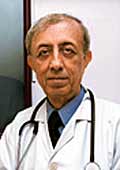 |
| Escorts Heart Institute's Naresh Trehan:
He wants accreditation and uniform pricing in the industry
to attract more foreigners |
Airport
pick-up, a swank suite, interpreter service, home cuisine, home
cable channels, a visit to the Taj Mahal... It is the Indian hospitality
industry going out of its way to woo the foreign tourist, right?
Well, actually, the industry in question is not that of hotels,
but of hospitals (yes, you read that correctly). In a dozen or so
state-of-the-art hospitals in the country, the number of foreigners
coming for treatment is clipping. An estimated 100,000 "medical
tourists" visited India last year, representing a 20 per cent
jump over the previous year. A CII-McKinsey report suggests that
medical tourism could fetch as much as $2 billion by 2012, compared
to an estimated $333 million currently.
But what's new about people coming to India
seeking wellness? After all, haven't they been coming to the country
for decades now to experience yoga, Ayurveda and spirituality? Yes,
but the medical tourists that we are talking about are those seeking
critical medical care such as heart surgery, organ transplant, knee
or hip replacement, or even something as simple as a root canal
treatment. But a caveat may be in order here: It is not as if hospitals
across India have suddenly become destination points for the ailing
visitor. Most of the medical tourists end up going to a dozen or
so hospitals, simply because these are the ones that have invested
in state-of-the-art medical equipment, modern buildings, and world-class
systems and practices, besides employing top-notch doctors, most
of whom have worked abroad.
Take Escorts Heart Institute and Research Centre
(EHIRC) as an example. It performs 4,000 heart operations every
year, with an infection rate of less than 0.3 per cent and a mortality
rate lower than 1 per cent. Or Apollo Hospitals, which is said to
be the single-largest private hospital group in Asia with a network
of 35 hospitals and 6,400 beds. It has performed more than 49,000
cardiac surgeries with a success rate of 98.5 per cent, and over
130 successful bone marrow transplants. There are 4,000 specialists
and super-specialists and 3,000 medical officers (read: residents
doing their specialisation) who work for Apollo in 53 different
clinical departments. And there are at least a dozen other hospitals
such as Wockhardt, Breach Candy, CARE, Narayana Hrudayalaya (See
The Top Five), which are considered equally good.
 |
 |
| WE LOVE INDIA: (L) Julia,
a five-month-old baby from Tanzania with multiple holes in her
heart, was successfully treated at EHIRC; (R) Kerry Dickson
(standing) came all the way from Australia to Apollo Indraprastha
for the treatment of his wife, who was suffering from multiple
pelvic bone fracture |
The result: A growing number of believers in
India's medical capabilities. Says Gregory Bates, a former world
powerlifting champ from the UK, who underwent a coronary bypass
surgery at Wockhardt in Bangalore: "I have no hesitation in
saying that I got the best treatment I could have anywhere in the
world." Bates is now recuperating in Goa following his discharge.
Frustrated by the quality of medical attention in his home country,
Mohammad Zakir Hussain, a 36-year-old Bangladeshi turned to Apollo
Gleneagles Hospital in Kolkata for a cure to his inflammatory skin
disease called discoid lupus erythematosus (DLE). He was more than
impressed with the attention he received at Apollo. Says Vijai Kumar,
Medical Director, Jaslok Hospital, Mumbai: "Most of our patients
come through word-of-mouth publicity."
Like Henry McInnes, a software engineer based
in Seattle. After checking with his friends in Bangalore, McInnes
decided to get his root canal treatment done in India. He figured
that for the $4,000 he would have had to spend in the US, he could
not just get the treatment done in Bangalore, but throw in a vacation
too (now you know why they are called medical tourists!). A lack
of reference, however, doesn't deter the determined. When Richard
Ng'etich, a UNDP employee from Tanzania, discovered that his five-month-old
daughter had multiple holes in her heart, he trawled the internet
to find the best hospital, both in terms of quality and cost. He
ended up at EHIRC in July, and now his baby girl, Julia, is recovering
nicely. "I am glad we came here," says Ng'etich, also
delighted that the surgery cost him half of what it would have in
South Africa.
Indeed, that is the compelling proposition
offered by the top hospitals in the country (that the quality will
be world class is taken for granted), and what's helping them convince
foreign patients to come to them for treatment is the soaring cost
of healthcare in countries like the US and the UK. A cardiac surgery
in the US costs anywhere between $40,000 and $50,000. In India,
it costs a quarter or fifth of that in the best hospitals. Want
a hip replacement done? It costs $10,000 in India compared to $50,000
in the US. What about neuro-surgery? Around $8,000 against the $29,000
it would cost in the US. Notes Anupam Verma, Director (Administration),
P.D. Hinduja National Hospital and Medical Research Centre: "A
foreign patient gets treated by a world-class doctor with the same
GE machine and similar ambience at one-fifth the cost."
 |
| Vijai Kumar, Medical Director, Jaslok Hospital:
Jaslok counts on word-of-mouth publicity to do the trick |
Patients covered under insurance progammes like
the National Insurance of Health (NIH) or the National Health Services
(NHS) in the UK have long waiting periods, ranging from six to 18
months. To beat the queue, most patients are forced to go in for
private health insurance, which costs a bomb. Patients who can't
wait or opt for private insurance, then, end up coming to a country
like India, where they get pampered silly at bargain prices. A case
in point: Anette Ulstrup, a 46-year-old nurse from Denmark, who
came to Apollo Indraprastha in Delhi for an adrenalectomy (surgical
removal of one or both adrenal glands). At the price she was willing
to pay, she got to stay in a hospital suite that cost Rs 12,000
a day, besides which the hospital even organised a trip for the
Ulstrups to the Taj Mahal.
Bring 'Em On
To increase the flow of medical tourists, the
top hospitals are beefing up their marketing. Apollo, which has
an international marketing team that manages in-bound patients from
arrival to departure, has offices in the Middle East and Mauritius,
and is opening newer ones in Sri Lanka, Nigeria, and Malaysia. The
Hinduja hospital has a coordination centre in London, which facilitates
registration of patients from Europe. Sankara Nethralaya has tie-ups
abroad that channelise patients to itself. EHIRC has two facilitation
centres with limited diagnostic capabilities in Bangladesh, and
two more are to be opened in Kabul and the UAE. Manipal Hospital,
on the other hand, has set up information centres in several countries,
including the UK and the UAE, while Narayana Hrudayalaya has a tie-up
with the government of Kenya, besides information centres in Bangladesh
and Malaysia.
Interestingly enough, the leading hospitals
are even considering tying up with hotel chains to make the description
medical tourism, literal. Apollo Gleneagles, which plans to double
its revenues from foreign patients to Rs 8 crore in 2005-06, is
in talks with Hyatt Regency to offer its foreign patients a comprehensive
medical-cum-tourism package. Apollo Gleneagles, of course, is just
one example. Says Pratap C. Reddy, Chairman of Apollo Hospitals
and the man who corporatised health care in India: "We have
the best healthcare professionals in the world and super-speciality
hospitals. What we need is aggressive and concerted marketing."
 |
| Pratap C. Reddy, Chairman, Apollo Hospitals:
He already runs the biggest chain of corporate hospitals in
India, but wants to market more aggressively |
With medical tourist numbers clipping at 30
per cent a year, there is a rush to add beds, rope in doctors with
international experience, and stay up to date with advances in medical
technology. Manipal Hospital has started work on the US Joint Commission
International Accreditation, an industry certification for quality
standards. It already has an iso certification for meeting European
quality standards. Narayana Hrudayalaya is increasing its bed count
from 460 to 780, and the number of operating theatres from 10 to
30. Fortis Health Care, awarded the Best New Hospital Designed Worldwide
by the American Association of Architects in 1999, has four facilities
in operation, but plans to add three new hospitals in and around
Delhi.
There's another reason why international patients
are being wooed with such fervour. The rates for them are higher.
Apollo and Manipal have dollar rate cards, where the charges work
out to 10-12 per cent higher than the rupee rates. Hinduja levies
a 25 per cent surcharge on foreign patients and Jaslok, 20 per cent.
Even Fortis has a differential rate. Needless to say, all value-added
services such as airport pick-up, translator services, or home cuisine
are billed separately.
Some in the industry, however, think that differential
pricing is not a good practice. Also, there's the issue of different
hospitals charging different rates for the same procedure-something
that leaves international patients confused. According to Naresh
Trehan, Executive Director of EHIRC and a top-notch surgeon, "accreditation
of hospitals, uniform price banding like in the developed countries
and organised campaigns will encourage more overseas patients to
get treated here."
The industry is working on creating some kind
of standards. "We are talking to various agencies, including
credit rating agencies, insurance companies, CII for standardising
different functions," informs Dr Ramakant Panda, CEO, Asian
Heart Institute of Mumbai. Then, there is the need for external
auditing and monitoring of doctors' performance-something unheard
of in India. "We want to make it a big game, to use the clear
advantage for the next five decades," says Reddy of Apollo.
"(India is) now ready to heal the world." As the numbers
show, more and more medical tourists are veering round to Reddy's
point of view.
-additional reporting by Arnab
Mitra, E. Kumar Sharma, Nitya Varadarajan, Shilpa Nayak
and Venkatesha Babu
|
